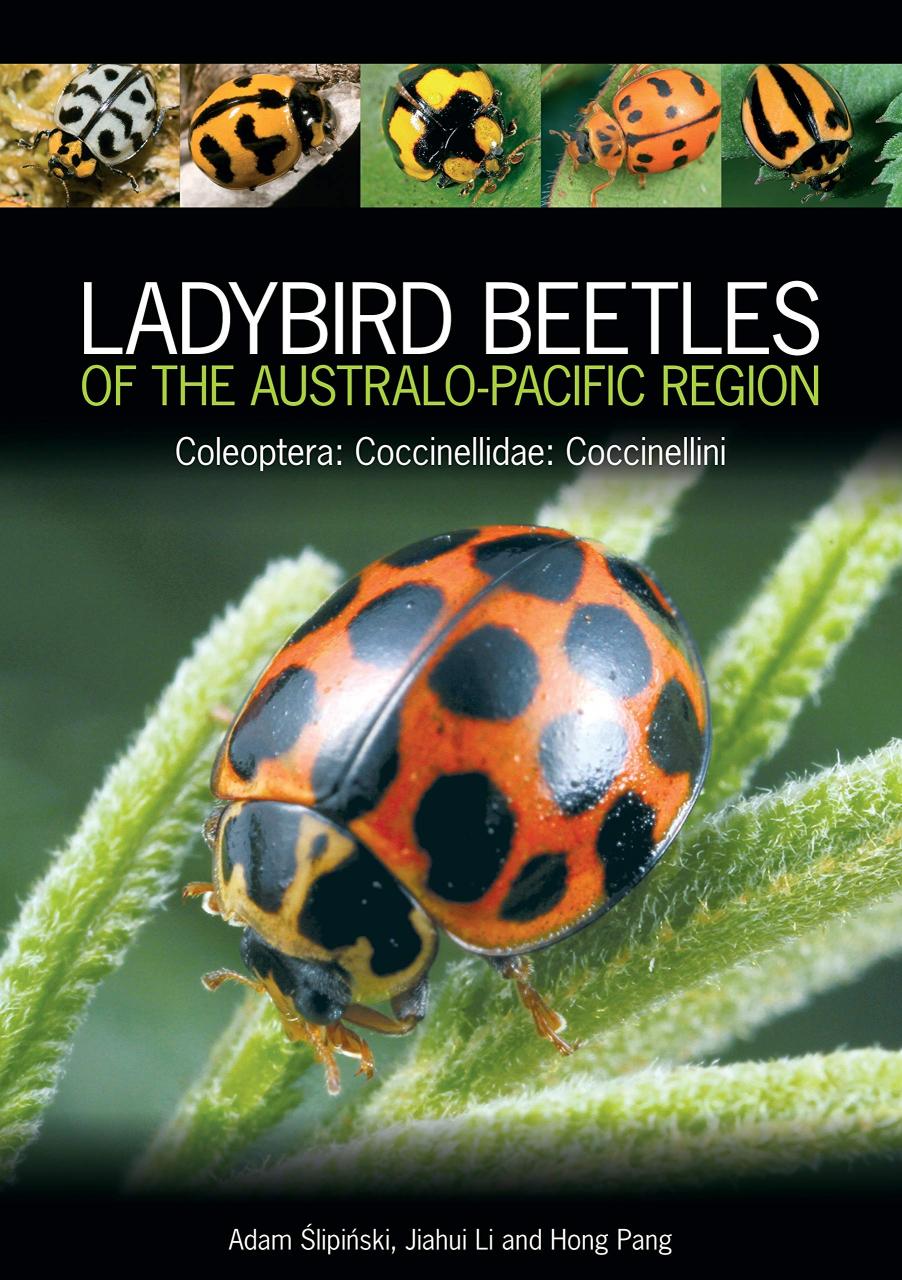Adam Ślipiński, Jiahui Li, Hong Pang
CSIRO Publishing
2020
ISBN: 9781486303878 (Hardback) 9781486303885 (eBook)
Reviewed by Peter Brown
A previous incarnation of this book (Ślipiński, 2007) has long been on my wish list, but has been out of print for some years, so this up-to-date taxonomic guide to the ladybirds (Coleoptera: Coccinellidae) of Australia and neighbouring Pacific countries is a very welcome arrival. Specifically, the book covers Australia, New Zealand, Papua New Guinea, Fiji and the other neighbouring smaller Pacific islands (clearly shown on a map that is rather hidden away about halfway through the book). Taxonomically it features the larger ‘conspicuous’ ladybirds, i.e. the Coccinellini, so tinier ladybirds such as Scymnus spp. are not featured.
It is quickly clear that this is a top-quality book written by a highly expert team, and it has well over 1,000 crisp and detailed colour images. The book must have involved an enormous amount of work in its preparation: over 10,000 specimens were examined over a ten-year period. The species covered are clearly listed early on in the book, with the countries for each species in the systematic list helpfully identified. Given the huge geographic area of the book I was slightly surprised that only 95 species are featured, but assume these are all that are known.
The book starts with an introduction to the historic, and rather fluid, classification of ladybirds, then quickly moves on to descriptions of the morphology of the group. It is evident that this is a book for the serious entomologist rather than the casual reader (who in any case would no doubt be deterred by the book’s high price).There are two keys: firstly, one for the genera of the whole region; secondly, a useful key to species level, but just for the mainland Australia species (i.e. about half of all the species featured). Whilst I was unable to test the keys, both seem clear for an entomologist. The species-level key is based on external characters, particularly patterns on elytra and shapes and patterns of pronota.
From page 14 we move to the meat of the book, with just under 100 pages of genera and species accounts. Firstly, for each species a list of synonyms is shown, which is helpful given the changing nature of ladybird classification. Each species then has a description containing a lot of detail,split into colour pattern and morphology. Detailed measurements of various ladybird body dimensions are provided. For each species there is a list of specimens examined and a useful remarks section, which often refers to uncertain taxonomy. Each species also has a paragraph on distribution, with a map.The maps are straightforward and clear, with broad distributions shaded and dots to indicate isolated records. It must be the case that the distributions shown are based on very incomplete information (perhaps especially for the Pacific Islands?), albeit no doubt the best that is available. (Drawing comparisons to the UK in this respect is clearly very unfair, given the radically different human population densities and recording effort.)
A comprehensive – featuring over 200 sources – and very useful bibliography follows, but is rather hidden in the middle of the book and would perhaps be better moved to the end. Following that is the second meaty section of the book: about 110 full colour photographic pages of the ladybirds. This starts with an overview of the group with six pages of colour photos of ladybirds on foliage and the like. Here adults of about 25 species are shown, and larvae of four species. There is then a page of well-labelled diagrams showing general ladybird adult morphology, followed by two pages of photographs illustrating general genital morphology and general larval and pupal morphology. These will no doubt be useful for anyone getting to grips with detailed ladybird taxonomy.After the aforementioned coverage map, there are three very useful pages of photographs showing key characters of the genera. These are to accompany the key that is placed very early in the book, and it is a shame that the two are not together (presumably because the colour portion of the book needed to be all together to reduce printing costs). The same comment applies to the three pages of photos of the Australian species. Many of these are shown directly from above, with some shown side-on or head-on.The latter are useful as they more clearly show the three-dimensional shapes of the ladybirds: how domed they are, whether there is a ridge around the elytra, and shapes of pronota are important features of identification.
After the above more general pages, there is a full colour page of photographs for each of the 95 species, shown usefully in alphabetical rather than taxonomic order. The detail here is impressive: typically, 9-12 images per species are shown, and sometimes more. The three-dimensional adult ladybird shapes are clear to see, from the extraordinarily broad, flat and beautifully patterned Australoneda horni to the more typically-shaped and much plainer Micraspis aphidectoides. The book comes into its own with the very large and clear pictures of ladybird genitalia and abdomens. I am no expert in these structures, but they appear to have been very expertly prepared and photographed.
Overall, I highly recommend this book to ladybird taxonomists and anyone with a strong interest in ladybirds generally. Whether the reader is trying to identify Australian ladybirds using obvious external characters or by dissection, this book will excellently fit the bill. Unfortunately, the very high price will probably restrict its wider appeal, even among serious entomologists, and I think this is a great shame. The beauty and diversity of the ladybirds of this region are clear from the book, but an opportunity to bring them to a wide audience has been missed.
Ślipiński,A. (2007). Australian Ladybird Beetles (Coleoptera: Coccinellidae):Their Biology and Classification. Australian Biological Resources Study.


